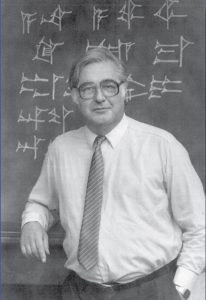
The history of Assyriology in Belgium stretches more than hundred years back. In the late 19th century teaching and research in Akkadian, the semitic language that many cuneiform texts were written in, began. However, the field blossomed the most after Georges Dossin finished his doctorate. He worked with some French excavations famous for finding many thousands of cuneiform texts and he showed his depth of knowledge in the disciplines of history and philology. Assyriology in Belgium later became defined by Dossin and his students, one of which were Léon De Meyer.
Assyriology was established in Ghent in 1965, when Léon De Meyer was appointed as the first professor of cuneiform philology. He lent the institute international standing, with the excavations at Tell ed-Der, ancient Sippar-Amnānum, and with the organization of the Rencontre Assyriologique Internationale in 1989, a feat which was later repeated in 2013. While he served as dean of the Arts faculty and subsequently as rector of the University from 1985-1993, the practical organization of the Assyriology department fell to Michel Tanret who succeeded De Meyer after his retirement. Since Tanret’s retirement in 2011, Katrien De Graef is leading the department.
From 1996-2011, the seat of the inter-university program “Greater Mesopotamia: Reconstruction of its Environment and History,” combining (geo)-archaeological, historical, and philological research at the Universities of Ghent, Leuven and Liège, and the Royal Belgian Institute of Natural Sciences.
The discovery of the archive of Ur-Utu, chief lamentation priest in the temple of Annunitum in Sippar-Amnānum in the 17th century BCE, offered many lines of research, into the chronology of Babylonia during the second millennium BCE, archival studies, sealing practices and social and economic history of Babylonia. Today, the Assyriology department in Ghent has added gender studies and digital humanities to this list and is one of the few centers of Elamite studies worldwide.
For more, see: Katrien De Graef, “Tintin in Mesopotamia : the story of Belgian assyriology (1890-2017).” Following the Footsteps of Our Predecessors : Glimpses on into the Historiography of Ancient near Easter Studies, edited by Agnès Garcia-Ventura and Lorenzo Verderame, Eisenbrauns, 2020, pp. 252–65.